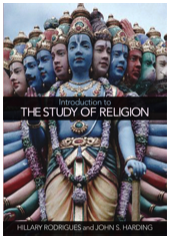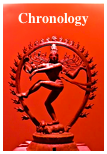





Glossary - M




magic: activities involving the manipulation of features of reality that are hidden to the non-practitioner, and which thus appear mysterious or miraculous.
mandala: geometrical cosmic map, especially in Tantric Buddhism and Hinduism.
martyrdom: derived from the Greek term for witness; condition of willingness to suffer or die for one’s religious beliefs.
Marxism: political and economic philosophy based on the teachings of Karl Marx with an emphasis on class struggle and economic constraints on history and culture; typically socialist or communist, as opposed to capitalist.
matriarchy: a society dominated by women.
mediate: to intervene, link, or convey; as opposed to immediate.
medium: person who claims to communicate with spirits or through whom spirits communicate and are consulted.
messianic:relating to a messiah, a savior; especially the Messiah prophesied in the Old Testament to deliver the Jewish nation or to Jesus, who is understood by Christians to be the promised Messiah and savior of humankind.
metanoetic: beyond noetic; mystical experience, for example, is often described as a deep insight into truth and reality beyond the reach of rational, discursive, mental activity and intellect to which noetic is related.
metaphysics: beyond physics; branch of philosophy that typically includes cosmology, ontology, and epistemology; it probes into questions concerning the ultimate nature of existence.
methodology: system of methods used within a given discipline or area of study.
milieu: the social environment, context, setting, or backdrop.
millenarianism: believing in a coming golden age of peace—often with a sense that this age is imminent or, at least, inevitable; sometimes used for a group seeking radical change to solve current societal problems; often used for the Christian notion of a future 1,000 year period of Christ’s reign.
mimetic desire: the motive force that concerns desiring that which others desire; for René Girard, the origins of violence and the sacred are linked to this desire.
mind-brain: refers to the multiple neuro-cognitive systems responsible for how we understand reality, and act in various settings and situations.
missionary: one who typically leaves home for a distant place with the intention of converting others to a particular set of beliefs often through teachings and charitable deeds.
modernism: primarily intellectual and aesthetic movement of the late 19th – early 20th century that reacted against tradition by promoting change and novelty.
moksha: Sanskrit term primarily found in Hinduism to refer to release from the bondage of ignorance, illusion, and the cycles of rebirth.
monastic: a monk or nun living in solitude or religious community; relating to these renunciants, their monastery, or way of life.
monism: belief in oneness; notion that there is ultimately only one substance or essence; no distinction between god and the world or matter and mind.
monk: male monastic; often living under religious vows along with other men.
monotheism: belief in the existence of a single god (i.e., God); Islam is a monotheistic religion.
morality: a code of virtuous conduct based on accepted notions of right and wrong.
mysticism: generally applied to a religious approach entailing a direct (i.e., unmediated) personal engagement with a supernatural principle or deity.
myth: typically ancient story involving supernatural events and beings, such as deities and heroes, believed to be true by particular communities.
mythology: collective of traditional stories believed by some to be true and pertaining to past events that involve supernatural deeds, events, or persons, such as deities, spirits, or heroic human beings.
SCHOLARLY APPROACHES
TO THE STUDY
AND TEACHING OF RELIGION






















-
(C)Hillary Rodrigues and John S. Harding 2008; Courtesy Routledge
Publishers
Used By Permission, Sastor.com